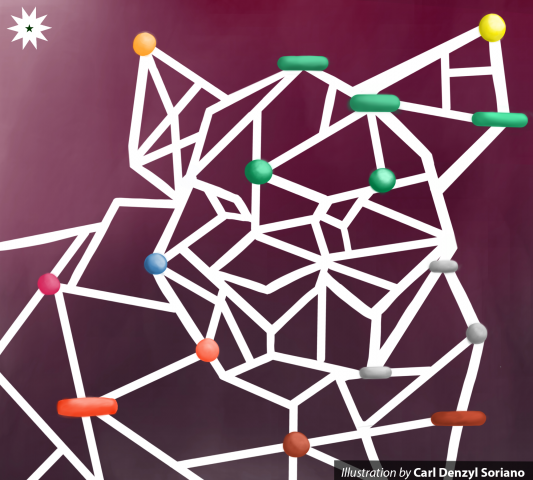Typically utilized in visualizing Engineering problems, process graphs (P-graphs) serve to represent the structure of process systems, and are considered bipartite graphs—where vertices of a distinct set are connected to vertices in a separate set that does not share any common element with the first set.
Its application in the field of Ecology was explored in a Philippine-American Academy of Science & Engineering (PAASE) webinar held last May 22. Presented by Dr. Angelyn Lao, Mathematics & Statistics Department Associate Professor and College of Science (COS) Assistant Dean for Research and Advanced Studies; and Vice Chancellor for Research & Innovation Dr. Raymond Tan, their study, Socio-Ecological Network Structures from Process Graphs, employed the P-graph methodology to analyze ecological networks or representations of biotic interactions in an ecosystem. In ecological networks, species are represented as nodes, whereas interactions are represented by links between nodes.
Mathematics and nature
Lao first presented existing modeling approaches applied to studying socio-ecological systems, which show the relationship between humans and nature. This led to a discussion on the composition of Earth’s biosphere, or the sum of all ecosystems, which in turn are defined as “biological communities of interacting organisms and their physical environment”.
As in all ecosystems, a “balance” is maintained either through the cycling or movement of abiotic resources like the water cycle and the carbon cycle, or through predator-prey systems. “Foxes depend on rabbits to survive, and without foxes, rabbits may end up being overpopulated,” the COS assistant dean illustrated a predator-prey interaction.
The Lotka-Volterra Model visualizes predator-prey relationships based on fixed positive constants—namely the “growth rate of prey, the rate at which predators destroy prey, the death rate of predators, and the rate at which predators increase by consuming prey”, as presented by Lao.
Lao also explained the relationship of each factor when plugged into the two differential equations of the model, “The change in the prey’s population [is] given by its own growth minus the rate at which it is preyed upon…[Meanwhile], the change in the predator population [is calculated] as growth fueled by the food supply minus [their] natural death.”
Detailing relationships
Lao pointed out that existing socio-ecological models are often presented with two challenges: an assumption that a single type of interaction predominates in systems, and ecological network analysis (ENA) models giving a “fragmented representation of real ecosystems”.
The COS assistant dean discussed that ENA uses “network theory to study the interactions between organisms or populations within their environment”—deepening the discourse on how individual relationships go on to interact with and influence one another within larger systems.
The identified relationships between species in an ecosystem were commensalism, where one species benefits while the other neither benefits nor is harmed; mutualism, where both benefit from each other; and antagonism, such as predation and parasitism, where one benefits at the expense of the other. Lao then introduced the three approaches in analyzing these relationships through networks.

One is the expanded food web, which “represents the net flow of energy among individuals”, such as from plants to herbivores, while taking into account how other “interactions may affect any parameter of the model”, like a competitor species that feed on the same plant. Another is the equal footing network, wherein “all interaction types are expressed in the same units,” suggesting that each component can contribute equally to the model. Lastly, the multilayer network tackles the “different types of connections between nodes”, with each layer in the model accounting for a different relationship.
A new approach
“In reality, ecosystem components play multiple roles relative to each other; thus, there is a need for a framework that allows concurrent modeling of these multiple roles and their resulting complex interactions,” Lao commented, demonstrating the significance of exploring a new approach to the problem.
That new approach came in the form of P-graphs, which Tan described as “a theoretical framework of process network synthesis”—representing a process structure through the interconnected vertices of a bipartite graph.
With the topic, Tan also presented the foundational axioms of P-graphs, which Lao explained need to be satisfied to construct a P-graph of a socio-ecological system.
Compared to ENA models, the utilization of P-graphs in better understanding ecological relationships allows for functional units—the species in the network—to be “well-defined” and represented through nodes in the P-graph. Furthermore, each functional unit may be linked to one or more other species in the ecosystem, depending on each scenario that may take place, as either an input or an output to the next node.
While ENA only provides information based on defined relationships from models, socio-ecological analysis using P-graphs details how each path or linkage leads to a terminal ecosystem service—be it provision of food for human consumption or collection of recyclable fossil mass—which serves as a goal for each model. All this, while taking into consideration how to minimize cost metrics such as ecological footprint, energy, or financial expenditures to meet the goal efficiently.
Presenting the advantage of employing P-graphs, Tan described the method as an “algorithmic procedure to take building blocks and [assemble] them into a complete network”, thereby providing “mathematical proof that the connections are complete and that there are no redundancies in the system”. In this sense, the ENA models are the building blocks that are synthesized or combined into a more comprehensive model to represent the ecosystem being studied.
“[Through this,] you will be able to generate a maximal structure which is sure to be correct,” he concluded. Using the P-graph approach to modeling is intended to better simulate the complex, interdependent relationships occurring in real ecosystems.
The presentation of the study may be accessed through this link: https://bit.ly/LaoSocioEcologicalNetworks.
